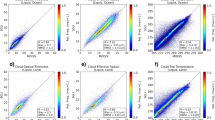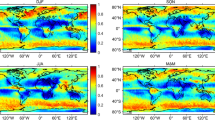Abstract
The Cloud Profiling Radar (CPR) onboard CloudSat is an active sensor specifically dedicated to cloud detection. Compared to passive remote sensors, CPR plays a unique role in investigating the occurrence of multi-layer clouds and depicting the internal vertical structure of clouds. However, owing to contamination from ground clutter, CPR reflectivity signals are invalid in the lowest 1 km above the surface, leading to numerous missed detections of warm clouds. In this study, by using 1-yr CPR and MODIS (Moderate Resolution Imaging Spectroradiometer) synchronous data, those CPR-missed oceanic warm clouds that are identified as cloudy by MODIS are examined. It is demonstrated that CPR severely underestimates the occurrence of oceanic warm clouds, with a global-average miss rate of about 0.43. Over the tropical and subtropical oceans, the CPR-missed clouds tend to occur in regions with relatively low sea surface temperature. CPR misses almost all warm clouds with cloud tops lower than 1 km, and the miss rate reduces with increasing cloud top. As for clouds with cloud tops higher than 2 km, the negative bias of CPR-captured warm cloud occurrence falls below 3%. The cloud top height of CPR-missed warm clouds ranges from 0.6 to 1.2 km, and these clouds mostly have evidently small optical depths and droplet effective radii. The vertically integrated cloud liquid water content of CPR-missed warm clouds is smaller than 50 g m−2. It is also revealed that CPR misses some warm clouds that have small optical depths or small droplet sizes, besides those limited in the boundary layer below about 1 km due to ground clutter.
Similar content being viewed by others

References
Ackerman, S. A., R. E. Holz, R. Frey, et al., 2008: Cloud detection with MODIS. Part II: Validation. J. Atmos. Oceanic Technol., 25, 1073–1086.
Barker, H. W., G. L. Stephens, and Q. Fu, 1999: The sensitivity of domain-averaged solar fluxes to assumptions about cloud geometry. Quart. J. Roy. Meteor. Soc., 125, 2127–2152.
Bony, S., and J.-L. Dufresne, 2005: Oceanic boundary layer clouds at the heart of tropical cloud feedback uncertainties in climate models. Geophys. Res. Lett., 32, L20806, doi: 10.1029/2005GL023851.
Chan, M. A., and J. C. Comiso, 2011: Cloud features detected by MODIS but not by CloudSat and CALIOP. Geophys. Res. Lett., 38, L24813, doi: 10.1029/2011gl050063.
Charlson, R. J., J. E. Lovelock, M. O. Andreae, et al., 1987: Oceanic phytoplankton, atmospheric sulphur, cloud albedo and climate. Nature, 326, 655–661.
Dong Xiquan, Xi Baike, Kennedy A., et al., 2014: A 19-month record of marine aerosol-cloud-radiation properties derived from DOE ARM mobile facility deployment at the Azores. Part I: Cloud fraction and single-layered MBL cloud properties. J. Climate, 27, 3665–3682.
Gao Wenhua, Sui Chung-hsiung, and Hu Zhijin, 2014: A study of macrophysical and microphysical properties of warm clouds over the Northern Hemisphere using CloudSat/CALIPSO data. J. Geophys. Res., 119, 3268–3280.
Han Ding, Yan Wei, Ye Jing, et al., 2013: Analyzing cloud, precipitation, and thermal structure characteristics of typhoons in eastern Pacific based on CloudSat satellite data. Chinese J. Atmos. Sci., 37, 691–704. (in Chinese)
Hartmann, D. L., and D. A. Short, 1980: On the use of earth radiation budget statistics for studies of clouds and climate. J. Atmos. Sci., 37, 1233–1250.
Holz, R. E., S. A. Ackerman, F. W. Nagle, et al., 2008: Global Moderate Resolution Imaging Spectroradiometer (MODIS) cloud detection and height evaluation using CALIOP. J. Geophys. Res., 113, D00A19, doi: 10.1029/2008JD009837.
Huang Yi, S. T. Siems, M. J. Manton, et al., 2012: The structure of low-altitude clouds over the southern Ocean as seen by CloudSat. J. Climate, 25, 2535–2546.
Jensen, M. P., A. M. Vogelmann, W. D. Collins, et al., 2008: Investigation of regional and seasonal variations in marine boundary layer cloud properties from MODIS observations. J. Climate, 21, 4955–4973.
Kubar, T. L., D. E. Waliser, and J.-L. Li, 2011: Boundary layer and cloud structure controls on tropical low cloud cover using A-train satellite data and ECMWF analyses. J. Climate, 24, 194–215.
Liu, C., and E. J. Zipser, 2009: “Warm rain” in the tropics: Seasonal and regional distribution based on 9 years of TRMM data. J. Climate, 22, doi: 10.1175/2008JCLI2641.1, 767–779.
Liu Qi, Fu Yunfei, and Feng Sha, 2010: Geographical patterns of the cloud amount derived from the ISCCP and their correlation with the NCEP reanalysis datasets. Acta Meteor. Sinica, 68, 689–704. (in Chinese)
Liu Shuang, Heygster G., and Zhang Suping, 2010: Comparison of CloudSat cloud liquid water paths in Arctic summer using ground-based microwave radiometer. J. Ocean. Univ. China, 9, 333–342.
Luo Yali, Zhang Renhe, and Wang Hui, 2009: Comparing occurrences and vertical structures of hydrometeors between eastern China and the Indian monsoon region using CloudSat/CALIPSO data. J. Climate, 22, 1052–1064.
Mace, G. G., R. Marchand, and Q. Zhang, et al., 2007: Global hydrometeor occurrence as observed by CloudSat: Initial observations from summer 2006. Geophys. Res. Lett., 34, L09808, doi: 10.1029/2006GL029017.
Marchand, R., G. G. Mace, T. Ackerman, et al., 2008: Hydrometeor detection using Cloudsat—An earthorbiting 94-GHz cloud radar. J. Atmos. Oceanic Technol., 25, 519–533.
Minnis, P., S. Sun-Mack, D. F. Young, et al., 2011: CERES Edition-2 cloud property retrievals using TRMM VIRS and Terra and Aqua MODIS data. Part I: Algorithms. IEEE Trans. Geosci. Remote. Sens., 49, 4374–4400.
Norris, J. R., 1998: Low cloud type over the ocean from surface observations. Part II: Geographical and seasonal variations. J. Climate, 11, 383–403.
Peng Jie, Zhang Hua, and Shen Xinyong, 2013: Analysis of vertical structure of clouds in East Asia with CloudSat data. Chinese J. Atmos. Sci., 27, 91–100. (in Chinese)
Platnick, S., M. D. King, S. A. Ackerman, et al., 2003: The MODIS cloud products: Algorithms and examples from Terra. IEEE Trans. Geosci. Remote Sens., 41, 459–473.
Schumacher, C., and R. A. Houze Jr., 2003: The TRMM precipitation radar’s view of shallow, isolated rain. J. Appl. Meteor., 42, 1519–1524.
Sun-Mack, S., P. Minnis, Y. Chen, et al., 2008: Boundary layer lapse rate in cloudy areas derived using CALIPSO data. Presentation material, CALIPSO Science Team Meeting, Paris, France. March, 2008.
Sun-Mack, S., P. Minnis, Y. Chen, et al., 2014: Regional apparent boundary layer lapse rates determined from CALIPSO and MODIS data for cloud-height determination. J. Appl. Meteor. Climatol., 53, 990–1011.
Tanelli, S., S. L. Durden, E. Im, et al., 2008: CloudSat’s cloud profiling radar after two years in orbit: Performance, calibration, and processing. IEEE Trans. Geosci. Remote Sens., 46, 3560–3573.
Wang Hui, Luo Yali, and Zhang Renhe, 2011: Analyzing seasonal variation of clouds over the Asian monsoon regions and the Tibetan Plateau region using Cloud- Sat/CALIPSO data. Chinese J. Atmos. Sci., 35, 1117–1131. (in Chinese)
Wang Shuaihui, Han Zhigang, Yao Zhigang, et al., 2011: An analysis of cloud types and macroscopic characteristics over China and its neighborhood based on the CloudSat data. Acta Meteor. Sinica, 69, 883–899. (in Chinese)
Weisz, E., Li Jun, Menzel W. P., et al., 2007: Comparison of AIRS, MODIS, CloudSat, and CALIPSO cloud top height retrievals. Geophys. Res. Lett., 34, L17811, doi: 10.1029/2007GL030676.
Xi Baike, Dong Xiquan, P. Minnis, et al., 2014: Comparison of marine boundary layer cloud properties from CERES-MODIS Edition 4 and DOE ARM AMF measurements at the Azores. J. Geophys. Res., 119, 9509–9529.
Yi Mingjian, Fu Yunfei, Liu Peng, et al., 2014: Deep convective clouds over the northern Pacific and their relationship with oceanic cyclones. Adv. Atmos. Sci., 32, 821–830, doi: 10.1007/s00376-014-4056-9.
Yin Jinfang, Wang Donghai, Zhai Guoqing, et al., 2013: Observational characteristics of cloud vertical profiles over the continent of East Asia from the Cloud- Sat data. Acta Meteor. Sinica, 27, 26–39, doi: 10.1007/s13351-013-0104-0.
Zhang, G. J., A. M. Vogelmann, M. P. Jensen, et al., 2010: Relating satellite-observed cloud properties from MODIS to meteorological conditions for marine boundary layer clouds. J. Climate, 23, 1374–1391.
Zhang, M. H., W. Y. Lin, S. A. Klein, et al., 2005: Comparing clouds and their seasonal variations in 10 atmospheric general circulation models with satellite measurements. J. Geophys. Res., 110, D15S02, doi: 10.1029/2004JD005021.
Zuidema, P., D. Painemal, S. de Szoeke, et al., 2009: Stratocumulus cloud-top height estimates and their climatic implications. J. Climate, 22, 4652–4666.
Author information
Authors and Affiliations
Corresponding author
Additional information
Supported by the National Natural Science Foundation of China (41175032).
Rights and permissions
About this article
Cite this article
Liu, D., Liu, Q. & Zhou, L. Underestimation of oceanic warm cloud occurrences by the Cloud Profiling Radar aboard CloudSat. J Meteorol Res 29, 576–593 (2015). https://doi.org/10.1007/s13351-015-5027-5
Received:
Accepted:
Published:
Issue Date:
DOI: https://doi.org/10.1007/s13351-015-5027-5



